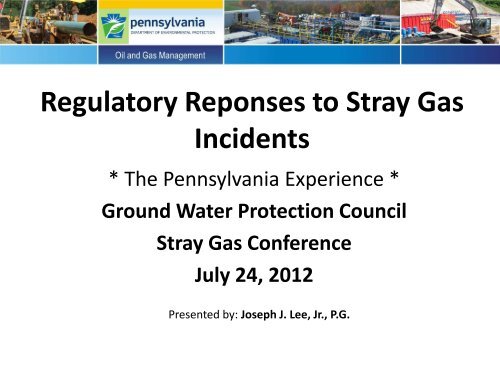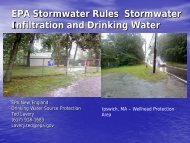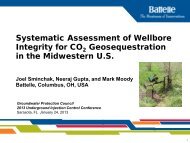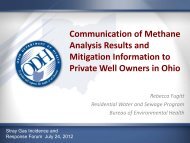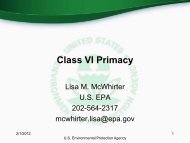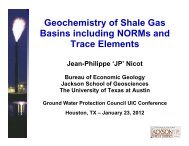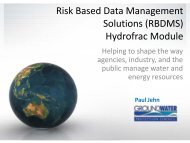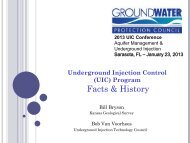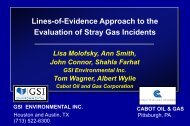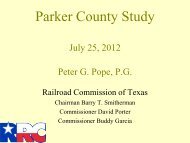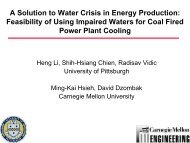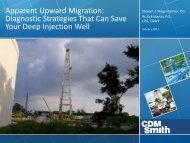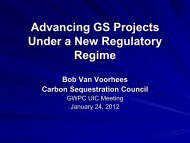Joe Lee - Groundwater Protection Council
Joe Lee - Groundwater Protection Council
Joe Lee - Groundwater Protection Council
Create successful ePaper yourself
Turn your PDF publications into a flip-book with our unique Google optimized e-Paper software.
Regulatory Reponses to Stray Gas<br />
Incidents<br />
* The Pennsylvania Experience *<br />
Ground Water <strong>Protection</strong> <strong>Council</strong><br />
Stray Gas Conference<br />
July 24, 2012<br />
Presented by: Joseph J. <strong>Lee</strong>, Jr., P.G.
PA HISTORY RESOURCE DEVELOPMENT
Regulatory Control of Stray Gas Incidents<br />
>2007 HISTORY RESOURCE<br />
Prevention – Surveillance - Response<br />
DEVELOPMENT<br />
• Identification of deepest fresh ground water<br />
• Casing & cementing standards<br />
• Pre-drill surveys<br />
• Emergency response plans<br />
• Water supply replacement requirements<br />
• Investigation protocols & monitoring<br />
• Mechanical integrity testing, bonding logs<br />
• Remediation
Final Rulemaking 25 Pa. Code Chapter 78<br />
Background<br />
• Initial draft presented to TAB September 17, 2009<br />
‣ DEP met with TAB and subcommittee four additional times<br />
(10/28/09, 1/14/10, 1/21/10, 3/25/10)<br />
• Advanced Notice of Proposed Rulemaking: Public<br />
comment period January 30, 2010 – March 2, 2010<br />
• Notice of Final Rulemaking: Public comment period<br />
July 10, 2010 – August 9, 2010<br />
• Approval by EQB, IRRC, Attorney General’s Office.<br />
• Final Regulations approved on publication in the<br />
Pennsylvania Bulletin February 5, 2011
Chapter 78 Major Changes to Well Construction and<br />
Cementing and Other Changes to Subchapter D<br />
• Revised casing standards<br />
• New requirement for<br />
casing and cementing plan<br />
• New Section on lost<br />
circulation<br />
• Revised cement standards<br />
• New Section on<br />
mechanical integrity of<br />
existing wells
78.83. Surface and Coal Protective Casing and<br />
Cementing Procedures: New Language<br />
• Surface casing set depth: may not be set more than 200 feet<br />
below the deepest fresh groundwater except as necessary to set<br />
the casing in consolidated rock (Two string vs. three string)<br />
• Surface casing hole must be drilled using air, freshwater, or<br />
freshwater-based drilling fluid<br />
• Wellbore conditioning required<br />
• Centralizers now required: surface casing- at least one within 50<br />
ft. of the surface casing seat, then in intervals no greater than<br />
every 150 ft. above the first centralizer<br />
• Coal protective string must have at least two centralizers, one<br />
within 50 ft. of the casing seat and the second within 100 ft. of<br />
the surface<br />
• Intermediate and production casing centralizers required (DEP<br />
does not prescribe number and placement)
78.75a. New Section: Area of Alternative Methods<br />
• DEP may designate an area of alternative methods if it<br />
determines that well drilling and operating requirements<br />
beyond those provided in this Chapter are necessary<br />
• Notice of proposed area of alternative methods<br />
published in PA Bulletin<br />
• Wells drilled within this area must meet the<br />
requirements specified by the Department unless the<br />
operator obtains DEP approval to drill, operate or plug<br />
the well in a different manner that is at least as safe and<br />
protective of the environment as the requirements in the<br />
area of alternative methods
78.89. Stray Gas Mitigation Response<br />
• Establishes protocol for operator, DEP,<br />
and local emergency response<br />
agencies to determine the nature of a<br />
gas migration incident, assess the<br />
potential for hazards to public health<br />
and safety, and mitigate any hazard<br />
posed by the release of natural gas<br />
• Operator, in conjunction with the<br />
Department and local emergency<br />
response agencies, must take<br />
measures necessary to ensure public<br />
health and safety
Section 78.89: Gas Migration Response<br />
•A three-tiered approach<br />
Category 1 (Immediate Threat): detectable concentrations equal to or<br />
greater than 10% of the lower explosive limit (LEL) or combustible gas in a<br />
building or structure(s), or otherwise deemed Category 1 by the Department.<br />
Category 2 (Potential Threat): detectable concentrations less than<br />
10% of the LEL of combustible gas in a building or structure(s), and/or<br />
combustible gas greater than 50% of the LEL in the headspace of a water well,<br />
and/or visual or audible evidence of stray gas bubbling through a water well<br />
column or surface body, and/or detectable concentrations of stray gas in the<br />
soils, and/or concentrations of dissolved methane in water at or above 25% of<br />
the lower solubility limit for methane (7 mg/l).<br />
Category 3 (No Apparent Threat): none of the above conditions were<br />
met. If conditions indicate methane in groundwater at concentrations above 0.5<br />
mg/l, but below 7 mg/l, continued monitoring is necessary to ensure that<br />
concentrations do not trend to a Category 2 potential threat.
Other Responses<br />
• Workgroup on Casing & Cementing<br />
• Workgroup on DFGW<br />
• Building expertise<br />
• Training & Resources
Joseph J. <strong>Lee</strong>, Jr.<br />
Pennsylvania Department of Environmental<br />
<strong>Protection</strong><br />
Bureau of Oil & Gas Program Planning &<br />
Management<br />
(717)772-2199<br />
joslee@pa.gov


